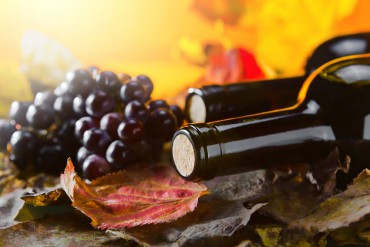 I have been curious about the origin of wines and their names since I began writing about wine in 1988, so I decided to start researching the information. Here is the first look, along with some tasting notes, so be prepared for more in the future.
I have been curious about the origin of wines and their names since I began writing about wine in 1988, so I decided to start researching the information. Here is the first look, along with some tasting notes, so be prepared for more in the future.
Cabernet Sauvignon
The word “sauvignon” is believed to be derived from the French “sauvage,” meaning “wild,” and to refer to the grape being a wild Vitis vinifera vine native to France. The meaning of the word cabernet is unknown.
The grape’s true origins were discovered in 1996 with the use of DNA typing at the UC Davis Department of Viticulture and Enology by a team led by Dr. Carole Meredith. The DNA evidence determined that cabernet sauvignon was the offspring of cabernet franc and sauvignon blanc and was most likely a chance crossing that occurred in the 17th century.
Prior to this discovery, this origin had been suspected from the similarity of the grapes’ names and the fact that cabernet sauvignon shares similar aromas with both grapes — such as the black currant and pencil box aromas of cabernet franc and the grassiness of sauvignon blanc.
Some excellent Cabernet Sauvignon wines:
- Dry Creek Vineyards, Cabernet Sauvignon, 2010 (Healdsburg, Calif.) $25. Blend: 83 percent cabernet sauvignon, 9 percent merlot, 4 percent malbec, 2 percent cabernet franc, 2 percent petit verdot. Style: dry red. Dark red color. Aromas: raspberry, sage and dried flowers. Flavors: black cherry, plum and cocoa. Well-balanced palate with superior tannins. Full body; lingering finish with fine tannins that are elegant and structured (alc. by volume 13.5 percent).
- Frisson Winery, Russian River Valley, Cabernet Sauvignon, 2010 (Napa, Calif.) $65. Style: dry red. Dark red color. Aromas: black currant, blackberry and dark chocolate with cardamom spice and mocha oak; flavors: dark cherry and coffee. Palate finishes with a harmonious tannin balance. Medium body (alc. by volume 13.9 percent).
- Woodward Canyon, Old Vine Cabernet Sauvignon, 2011 (Place of origin Lowden, Wash.) $44. Blend: 90 percent cabernet sauvignon, 5 percent petite verdot, 5 percent syrah. Style: dry red. Dark purple color. Aromas: earth, spice, black fruits, leather and mocha; flavors: black fruits and cassis, exotic spice of new oak. Palate: soft texture with beautifully integrated tannins. Full body; rich, lingering finish (alc. by volume 13.5 percent).
Merlot
The earliest recorded mention of merlot (under the synonym of merlau) was in the notes of a local Bordeaux official who in 1784 labeled wine made from the grape in the Libournais region as one of the area’s best. In 1824, the word merlot itself appeared in an article on Médoc wine that said that the grape was named after the local black bird (called merlau in the local Occitan language) that liked eating the ripe grapes on the vine.
Other descriptions of the grape from the 19th century called the variety lou seme doù flube (meaning “the seedling from the river”), with the grape thought to have originated on one of the islands found along the Garonne River.
In the late 1990s, researchers at University of California Davis showed that merlot is an offspring of cabernet franc and is a half-sibling of carménère, malbec and cabernet sauvignon. The identity of the second parent of merlot wouldn’t be discovered until the late 2000s when an obscure and unnamed variety, first sampled in 1996 from vines growing in an abandoned vineyard in Saint-Suliac in Brittany, was shown by DNA analysis to be the mother of merlot.
Some great Merlot wines:
- Woodward Canyon Winery, Merlot, 2011 (Lowden, Wash.) $44. Blend: 96 percent merlot, 4 percent cabernet franc. Style: dry red. Dark red color. Aromas and flavors: rich black cherry fruit, spiced oak, leather and earth. Palate: elegant, high-toned fruit, very nice acidity and overall proportion and the complexity and structure to age well for six to eight years. Medium body; balanced finish (alc. by volume 14.3 percent).
- Columbia Crest, Merlot, Grand Estates, 2012 (Patterson, Wash.) $12. Blend: 96 percent merlot, 4 percent cabernet sauvignon. Style: dry red. Dark red color. Rich aromas of dark cherries and chocolate; complex flavors of fruit, mocha and caramel. Medium body; smooth, velvety finish (alc. by volume 13.5 percent).
Pinot Noir
The name is derived from the French words for pine and black; the pine alluding to the grape variety having tightly clustered, pine cone-shaped bunches of fruit. Pinot noir is a red wine grape variety of the species Vitis vinifera. Pinot noir’s home is France’s Burgundy region, particularly in Côte-d’Or. It is now planted in many countries around the world, including the United States (California and Oregon).
Some excellent Pinot Noirs:
- Domaine Serene, Pinot Noir, Yamhill Cuvee, 2009 (Salem, Ore.) $50. Style: dry red. Dark red color with purple hues. Aromas: floral aromas of cherry blossom and strawberry, with a touch of spring earth; flavors: jammy crushed cherry, plum and white pepper. Medium body; long, intense finish earth and rose pedal notes. Food pairing: grilled sea bass with herbed butter (alc. by volume 14.3 percent).
- Paul Dolan Vineyards, Pinot Noir, 2012 (Ukiah, Calif.) $30 (organically grown grapes). Style: dry red. Dark red color. Aromas: leather and sweet cocoa dust; flavors: bright strawberry-rhubarb. Medium body; balanced finish (alc. by volume 13.5 percent).
- Elouan, Oregon, Pinot Noir, 2013 (St. Helena, Calif.) $25. Style: dry red. Dark red color. Aromas: rose petal and sweet red fruit core; flavors: cherry, rhubarb and fresh tiled earth. Palate: firm acidity; medium body; balanced finish (alc. by volume 13.5 percent).



























